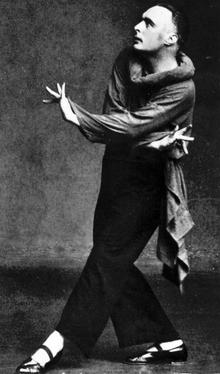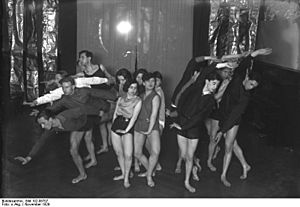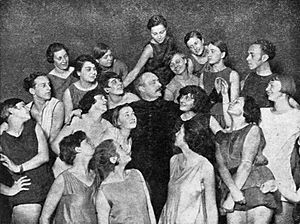Rudolf von Laban facts for kids
Quick facts for kids
Rudolf von Laban
|
|
|---|---|
 |
|
| Born | 15 December 1879 |
| Died | 1 July 1958 (aged 78) |
| Known for | Choreography, dance theory, Labanotation |
|
Notable work
|
Labanotation |
| Movement | Expressionist dance |
| Partner(s) | Lisa Ullman |
Rudolf von Laban (born December 15, 1879 – died July 1, 1958) was a very important dance artist, choreographer, and dance theorist. He was born in Austria-Hungary and later became German and British. Many people call him a "founding father of expressionist dance" and a leader in modern dance.
Laban created new ways to understand and write down human movement. These included Laban movement analysis and Labanotation. These ideas helped future dance notation and movement studies. He also started one of the main ways to use dance for therapy. His work on movement for plays was also very important. He even tried to use his ideas in other areas like architecture, education, and industry.
After preparing a dance for the 1936 Summer Olympics in Berlin, Laban faced problems. He found safety in England in 1937. From 1945 to 1946, he and his partner Lisa Ullmann started the Laban Art of Movement Guild in London. They also opened The Art of Movement Studio in Manchester. He worked there until he passed away. Today, the Trinity Laban Conservatoire of Music and Dance in London continues his work.
Contents
Rudolf Laban's Early Life and Work
Rudolf Laban was the son of Rudolf Laban Sr., a military leader. His father was honored by the Hungarian monarchy in 1897. This allowed Laban to use "von" in his name. Laban grew up in important cities like Vienna and Sarajevo.
When he was young, Laban joined a traditional dance group called a csárdás. At 15, he went to a military school. But he later decided not to be a soldier. In 1899, Laban moved to Munich to study art. There, he met Martha Fricke and they married in 1900. Their daughter, Azraela, was born in 1901.
Laban also took classes at a new art studio. In 1904, he moved to Paris to study architecture at a famous art school. His son, Arpad, was born in Paris in 1905. Sadly, his wife Martha died suddenly. Soon after, his father also passed away. Laban's children then lived with their grandparents.
For a few years, Laban moved between Paris, Vienna, and other cities. He became an accountant for a short time. Later, he lived with his mother in Vienna. He worked as an artist, drawing for magazines. He also studied old dance forms. In 1910, he married Maja Lederer and they moved to Munich.
In 1911, Laban opened a small dance studio in Munich. He still had to work as an artist to make money. In 1912, he became very tired and went to a health center. There, he met Suzanne Perrottet. She became a very important helper for his work.
During First World War, Laban started a school in Ascona, Switzerland. This place was a natural healing colony called Monte Verità. Many people interested in new dance styles came there. From 1913 to 1919, Laban held his famous summer dance courses there. Students tried to live simply, growing food and making clothes. They danced outdoors, trying out new movements. Laban's ideas about expressionist dance grew strong here.
In 1915, Laban, his wife, their children, and Suzanne Perrottet moved near Zurich. They lived a simple life, growing their own food. Laban also started a school for movement art in Zurich. It taught different types of dance, acting without words, and body experiments.
A big dance event happened in 1917 at Monte Verità. It was a three-part dance play called Sang an die Sonne. It showed the setting sun, night demons, and the rising sun. The sun's return showed hope for peace after the war. Famous dancers like Mary Wigman and Suzanne Perrottet performed there.
Laban's Dance Schools in Germany
After World War I, Laban went back to Germany. Suzanne Perrottet continued his school in Zurich. In 1922, Laban started the Tanzbühne Laban (Dance Stage Laban) in Hamburg.
His first public dance show was in Lübeck in 1922. It was called Der schwingende Tempel (The Swinging Temple). In 1923, the first Laban school opened with its own dance group. Many students from this school spread Laban's dance methods. Soon, 24 Laban schools opened across Europe.
Laban also created "Choreographic Institutes" in Würzburg and Berlin. He also directed the Chamber Dance Stage. Some of his dance work was shown in a popular German silent film from 1925. From 1930 to 1934, Laban led the ballet at the Berlin State Opera. He included ideas from psychologist Carl Jung and exercises from Joseph Pilates in his warm-up programs.
Laban During the Nazi Period
From 1934 to 1936, Laban directed big dance festivals. These were funded by the government's propaganda department. Laban wrote that they wanted to use dance to serve their country. In 1936, he became the head of "German workshops for dance."
However, Laban faced health problems. He also had to follow new laws that affected his work. For example, a law in 1933 limited who could attend schools. This meant Laban had to check students' backgrounds. Some people say he supported the Nazi ideas. But others say he had to do these things to survive in Germany at that time. He was not a German citizen or a Nazi party member. In 1936, a dance he created for the 1936 Summer Olympics was banned. The government said it did not support their goals.
Moving to England
Laban was very sick when he traveled to Paris in 1937. In 1938, he was invited to England. He joined two former students, Kurt Jooss and Sigurd Leeder, at their dance school in Devon. This school was a safe place for dancers from Nazi Germany.
Lisa Ullmann and Sylvia Bodmer helped Laban a lot with his dance teaching. Together, they started the Laban Art of Movement Guild in 1945. This is now known as Trinity Laban Conservatoire of Music and Dance. They also opened The Art of Movement Studio in Manchester in 1946.
In 1947, Laban wrote a book called Effort with Fredrick Lawrence. This book looked at how people move at work. Laban wanted to help people move more efficiently and save energy. In 1948, he published Modern Educational Dance. This book shared his ideas about teaching dance to everyone, including children. His ideas were used in many British schools. Rudolf Laban passed away in England in 1958.
Famous Students and Friends
Many talented people studied with Laban or worked closely with him. Some of them include Mary Wigman, Suzanne Perrottet, Kurt Jooss, Lisa Ullmann, and Irmgard Bartenieff.
Laban's Lasting Impact
The Laban Archive at Trinity Laban Conservatoire of Music and Dance has many documents about Laban's life and work. The Rudolf Laban Archive at the National Resource Centre for Dance also has his original drawings. Other places like the Tanzarchiv Leipzig also keep information about him.
Laban's students went on to start their own modern dance schools. They taught their own students throughout the 20th century. This shows how much Laban influenced dance.
- Rudolf von Laban
- Kurt Jooss (a type of dance called Ausdruckstanz)
- Pina Bausch (created Tanztheater)
- Mary Wigman (Expressionist dance)
- Ursula Cain
- Heike Hennig (known for Dancing with Time)
- Hanya Holm
- Valerie Bettis
- Alwin Nikolais—known for "decentralization"
- Ursula Cain
- Kurt Jooss (a type of dance called Ausdruckstanz)
*Murray Louis *Beverly Schmidt Blossom
See also
 In Spanish: Rudolf von Laban para niños
In Spanish: Rudolf von Laban para niños
- List of dancers
Works and Publications
- (Undated). Harmonie Lehre Der Bewegung (German). (A handwritten copy of a book by Rudolf Laban) London: Laban Collection S. B. 48.
- (1920). Die Welt des Taenzers [The world of Dancers] (German). Stuttgart: Walter Seifert. (3rd edition, 1926)
- (1926). Choreographie: Erstes Heft (German). Jena: Eugen Diederichs.
- (1926). Gymnastik und Tanz (German). Oldenburg: Stalling.
- (1926). Des Kindes Gymnastik und Tanz (German). Oldenburg: Stalling.
- (1928). Schriftanz: Methodik, Orthographie, Erlaeuterungen (German). Vienna: Universal Edition.
- (1929). "Das Choreographische Institut Laban" in Monographien der Ausbildungen fuer Tanz und Taenzerische Koeperbildung (German). Edited by Liesel Freund. Berlin-Charlottenburg: L. Alterthum.
- (1947). with F. C. Lawrence. Effort: Economy of Human Movement London: MacDonald and Evans. (4th reprint 1967)
- (1948). Modern Educational Dance. London: MacDonald and Evans. (2nd Edition 1963, revised by Lisa Ullmann)
- (1948). "President’s address at the annual general meeting of the Laban art of movement guild". Laban Art of Movement Guild News Sheet. 1 (April): 5–8.
- (1950). The Mastery of Movement on the Stage. London: MacDonald and Evans.
- (1951). "What has led you to study movement? Answered by R. Laban". Laban Art of Movement Guild News Sheet. 7 (Sept.): 8–11.
- (1952). "The art of movement in the school". Laban Art of Movement Guild News Sheet. 8 (March): 10–16.
- (1956). Laban’s Principles of Dance and Movement Notation. London: MacDonald and Evans. (2nd edition 1975, annotated and edited by Roderyk Lange)
- (1960). The Mastery of Movement. (2nd Edition of The Mastery of Movement on the Stage), revised and enlarged by Lisa Ullmann. London: MacDonald and Evans. (3rd Edition, 1971. London: MacDonald and Evans) (1st American Edition, 1971. Boston: Plays) (4th Edition, 1980. Plymouth, UK: Northcote House)
- (1966). Choreutics. Annotated and edited by Lisa Ullmann. London: MacDonald and Evans.
- (1974). The Language of Movement; A Guide Book to Choreutics. Annotated and edited by Lisa Ullmann. Boston: Plays. (American publication of Choreutics)
- (1975). A Life For Dance; Reminiscencs. Translated and annotated by Lisa Ullmann. London: MacDonald & Evans. (Original German published 1935.)
- (1984). A Vision of Dynamic Space. Compiled by Lisa Ullmann. London: The Falmer Press.



